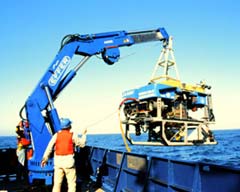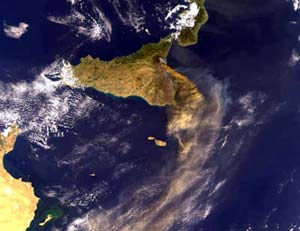Earth Sciences
Earth Sciences (also referred to as Geosciences), which deals with basic issues surrounding our planet, plays a vital role in the area of energy and raw materials supply.
Earth Sciences comprises subjects such as geology, geography, geological informatics, paleontology, mineralogy, petrography, crystallography, geophysics, geodesy, glaciology, cartography, photogrammetry, meteorology and seismology, early-warning systems, earthquake research and polar research.

New method strikes an improvement in lightning predictions
A new lightning index that uses measurements of water vapor in the atmosphere from Global Positioning Systems has improved lead-time for predicting the first lightning strikes from thunderstorms. The index will help greatly aid NASA Space Shuttle launches at Kennedy Space Center, Fla, and other commercial and U.S. Department of Defense launches from Cape Canaveral Air Force Station, Fla.
“Better forecasting and more advance warning of lightning strikes will help reduce the delays or cancell

DARE for planetary exploration
Balloons outfitted with innovative steering devices and robot probes could be the future of planetary exploration. Dr. Alexey Pankine, a fellow at the NASA Institute for Advanced Concepts (NIAC), presented an analysis of balloon applications for planetary science at the World Space Congress in Houston, Texas last month. His study, entitled Directed Aerial Robot Explorers or DARE, is funded by NIAC.
At the center of the DARE concept are balloons that can float in planetary atmospheres for man

New Generation Deep Ocean Vehicle Begins Science Operations for U.S. Researchers
JASON II reaches most of the world ocean floor and sends data ashore via the Internet
A new generation of remotely operated vehicle (ROV) capable of routine operation to depths of 6,500 meters (21,320 feet) and communicating its data back to shore via the Internet has been developed by the Woods Hole Oceanographic Institution (WHOI). The vehicle, JASON II, recently completed its first science cruise off the coast of Washington and Oregon and is currently at sea in the Pacific wo

Ocean temperatures affect intensity of the South Asian monsoon and rainfall
Warmer or colder sea surface temperatures (SST) may affect one of the world’s key large-scale atmospheric circulations that regulate the intensity and breaking of rainfall associated with the South Asian and Australian monsoons, according to new research from NASA.
A monsoon is a wind that changes direction with the seasons. Monsoons develop from changing patterns of atmospheric circulation which are caused by changes in heating and cooling of land and oceans. One of the strongest and most

Three ESA satellites reveal Etna’s complexity
As detected by ESA satellite sensors, the recent eruptions of the Mount Etna volcano in Sicily are throwing huge amounts of ash and trace gases into the atmosphere. Working with data from the Global Ozone Monitoring Experiment (GOME) sensor onboard ESA’s ERS-2 spacecraft, scientists at the German aerospace centre (DLR) report that levels of sulphur dioxide from the eruptions on Sunday and Monday are at least 20 times higher than normal.
As detected by ESA satellite sensors, the recent erupt

Computer model suggests future crop loss due to potential increase in extreme rain events
An increased frequency of extreme precipitation events has been observed over the last 100 years in the United States. Global climate models project that similar trends may continue and even strengthen over the coming decades, due to climate change. Now, a study using computer climate and crop model simulations predicts that U.S. agricultural production losses due to excess rainfall may double in the next 30 years, resulting in an estimated $3 billion per year in damages.
Cynthia Rosenzweig